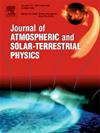Remote sensing of air pollutants in China to study the effects of emission reduction policies on air quality
IF 1.8
4区 地球科学
Q3 GEOCHEMISTRY & GEOPHYSICS
Journal of Atmospheric and Solar-Terrestrial Physics
Pub Date : 2024-12-01
DOI:10.1016/j.jastp.2024.106392
引用次数: 0
Abstract
Air Quality (AQ) is determined by the concentrations of aerosols and trace gases. Aerosol concentration is measured by the mass concentration of particles smaller than 2.5 μm (PM2.5) or 10 μm (PM10), while trace gases include ozone (O3), nitrogen dioxide (NO2), sulfur dioxide (SO2), and carbon monoxide (CO). Ammonia (NH3) and (biogenic) volatile organic compounds ((B)VOCs) also play an important role in atmospheric chemistry affecting the concentrations of trace gases and ultimately AQ. This study focuses on various aspects of AQ in China, utilizing remote sensing data from satellite and ground-based sensors to obtain information on PM emissions and concentrations and AQ-relevant trace gases. This research was conducted within the framework of the ESA/NRSCC MOST collaboration project Dragon 5, as part of the EMPAC (Exploitation of satellite remote sensing to enhance our comprehension of the Mechanisms and Processes influencing Air quality in China) project. It summarizes findings on four main topics: (1) Retrieval of trace gas concentrations and aerosol products from satellite data, validation using ground-based reference data, and interpretation of results in terms of AQ effects, such as the conversion of column-integrated properties to near-surface concentrations; (2) Determination of trace gases emissions relevant to AQ, using satellite data and models; (3) Analysis of time series data on trace gases and aerosols to assess the impact of emission reduction policies on AQ improvement; (4) Research contributing to a deeper understanding of mechanisms and processes affecting atmospheric composition about AQ.
求助全文
约1分钟内获得全文
求助全文
来源期刊

Journal of Atmospheric and Solar-Terrestrial Physics
地学-地球化学与地球物理
CiteScore
4.10
自引率
5.30%
发文量
95
审稿时长
6 months
期刊介绍:
The Journal of Atmospheric and Solar-Terrestrial Physics (JASTP) is an international journal concerned with the inter-disciplinary science of the Earth''s atmospheric and space environment, especially the highly varied and highly variable physical phenomena that occur in this natural laboratory and the processes that couple them.
The journal covers the physical processes operating in the troposphere, stratosphere, mesosphere, thermosphere, ionosphere, magnetosphere, the Sun, interplanetary medium, and heliosphere. Phenomena occurring in other "spheres", solar influences on climate, and supporting laboratory measurements are also considered. The journal deals especially with the coupling between the different regions.
Solar flares, coronal mass ejections, and other energetic events on the Sun create interesting and important perturbations in the near-Earth space environment. The physics of such "space weather" is central to the Journal of Atmospheric and Solar-Terrestrial Physics and the journal welcomes papers that lead in the direction of a predictive understanding of the coupled system. Regarding the upper atmosphere, the subjects of aeronomy, geomagnetism and geoelectricity, auroral phenomena, radio wave propagation, and plasma instabilities, are examples within the broad field of solar-terrestrial physics which emphasise the energy exchange between the solar wind, the magnetospheric and ionospheric plasmas, and the neutral gas. In the lower atmosphere, topics covered range from mesoscale to global scale dynamics, to atmospheric electricity, lightning and its effects, and to anthropogenic changes.
 求助内容:
求助内容: 应助结果提醒方式:
应助结果提醒方式:


